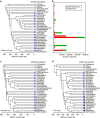Herbivory increases diversification across insect clades
- PMID: 26399434
- PMCID: PMC4598556
- DOI: 10.1038/ncomms9370
Herbivory increases diversification across insect clades
Abstract
Insects contain more than half of all living species, but the causes of their remarkable diversity remain poorly understood. Many authors have suggested that herbivory has accelerated diversification in many insect clades. However, others have questioned the role of herbivory in insect diversification. Here, we test the relationships between herbivory and insect diversification across multiple scales. We find a strong, positive relationship between herbivory and diversification among insect orders. However, herbivory explains less variation in diversification within some orders (Diptera, Hemiptera) or shows no significant relationship with diversification in others (Coleoptera, Hymenoptera, Orthoptera). Thus, we support the overall importance of herbivory for insect diversification, but also show that its impacts can vary across scales and clades. In summary, our results illuminate the causes of species richness patterns in a group containing most living species, and show the importance of ecological impacts on diversification in explaining the diversity of life.
Figures

Similar articles
-
Testing the Relationships between Diversification, Species Richness, and Trait Evolution.Syst Biol. 2016 Nov;65(6):975-988. doi: 10.1093/sysbio/syw029. Epub 2016 Apr 4. Syst Biol. 2016. PMID: 27048703
-
Host-plants shape insect diversity: phylogeny, origin, and species diversity of native Hawaiian leafhoppers (Cicadellidae: Nesophrosyne).Mol Phylogenet Evol. 2012 Nov;65(2):705-17. doi: 10.1016/j.ympev.2012.07.024. Epub 2012 Aug 4. Mol Phylogenet Evol. 2012. PMID: 22884527
-
Diversity and Role of Entomological Fauna Associated With Annona senegalensis (Magnoliales: Annonaceae) in Burkina Faso, West Africa.Environ Entomol. 2022 Oct 21;51(5):989-997. doi: 10.1093/ee/nvac040. Environ Entomol. 2022. PMID: 36124736
-
The impact of selenium on insects.J Econ Entomol. 2023 Aug 10;116(4):1041-1062. doi: 10.1093/jee/toad084. J Econ Entomol. 2023. PMID: 37289432 Review.
-
The ecology of predispersal insect herbivory on tree reproductive structures in natural forest ecosystems.Insect Sci. 2019 Apr;26(2):182-198. doi: 10.1111/1744-7917.12549. Epub 2017 Dec 27. Insect Sci. 2019. PMID: 29082661 Review.
Cited by
-
Opportunity begets opportunity to drive macroevolutionary dynamics of a diverse lizard radiation.Evol Lett. 2024 Jun 3;8(5):623-637. doi: 10.1093/evlett/qrae022. eCollection 2024 Sep. Evol Lett. 2024. PMID: 39328284 Free PMC article.
-
Revisiting the four Hexapoda classes: Protura as the sister group to all other hexapods.Proc Natl Acad Sci U S A. 2024 Sep 24;121(39):e2408775121. doi: 10.1073/pnas.2408775121. Epub 2024 Sep 19. Proc Natl Acad Sci U S A. 2024. PMID: 39298489
-
Coexpression of Three Odorant-Binding Protein Genes in the Foreleg Gustatory Sensilla of Swallowtail Butterfly Visualized by Multicolor FISH Analysis.Front Insect Sci. 2021 Jul 30;1:696179. doi: 10.3389/finsc.2021.696179. eCollection 2021. Front Insect Sci. 2021. PMID: 38468877 Free PMC article.
-
Taste evolution in an herbivorous drosophilid.bioRxiv [Preprint]. 2024 Feb 29:2024.02.27.582299. doi: 10.1101/2024.02.27.582299. bioRxiv. 2024. PMID: 38464294 Free PMC article. Preprint.
-
The causes of species richness patterns among clades.Proc Biol Sci. 2024 Jan 31;291(2015):20232436. doi: 10.1098/rspb.2023.2436. Epub 2024 Jan 24. Proc Biol Sci. 2024. PMID: 38262607 Free PMC article.
References
-
- Roskov Y.et al. (eds). Species 2000 & ITIS Catalogue of Life, 29th October 2014 Available at http://www.catalogueoflife.org/colSpecies 2000 (2014).
-
- Ehrlich P. R. & Raven P. H. Butterflies and plants: a study in coevolution. Evolution 18, 586–608 (1964).
-
- Southwood T. R. E. The insect/plant relationship–an evolutionary perspective. Symp. R. Ent. Soc. Lond 6, 3–30 (1973).
-
- Strong D. R., Lawton J. H. & Southwood T. R. E. Insects on Plants: Community Patterns and Mechanisms Harvard Univ. (1984).
-
- Mitter C., Farrell B. & Wiegmann B. The phylogenetic study of adaptive zones: Has phytophagy promoted insect diversification? Am. Nat. 132, 107–128 (1988).
Publication types
MeSH terms
Grants and funding
LinkOut - more resources
Full Text Sources
Other Literature Sources


